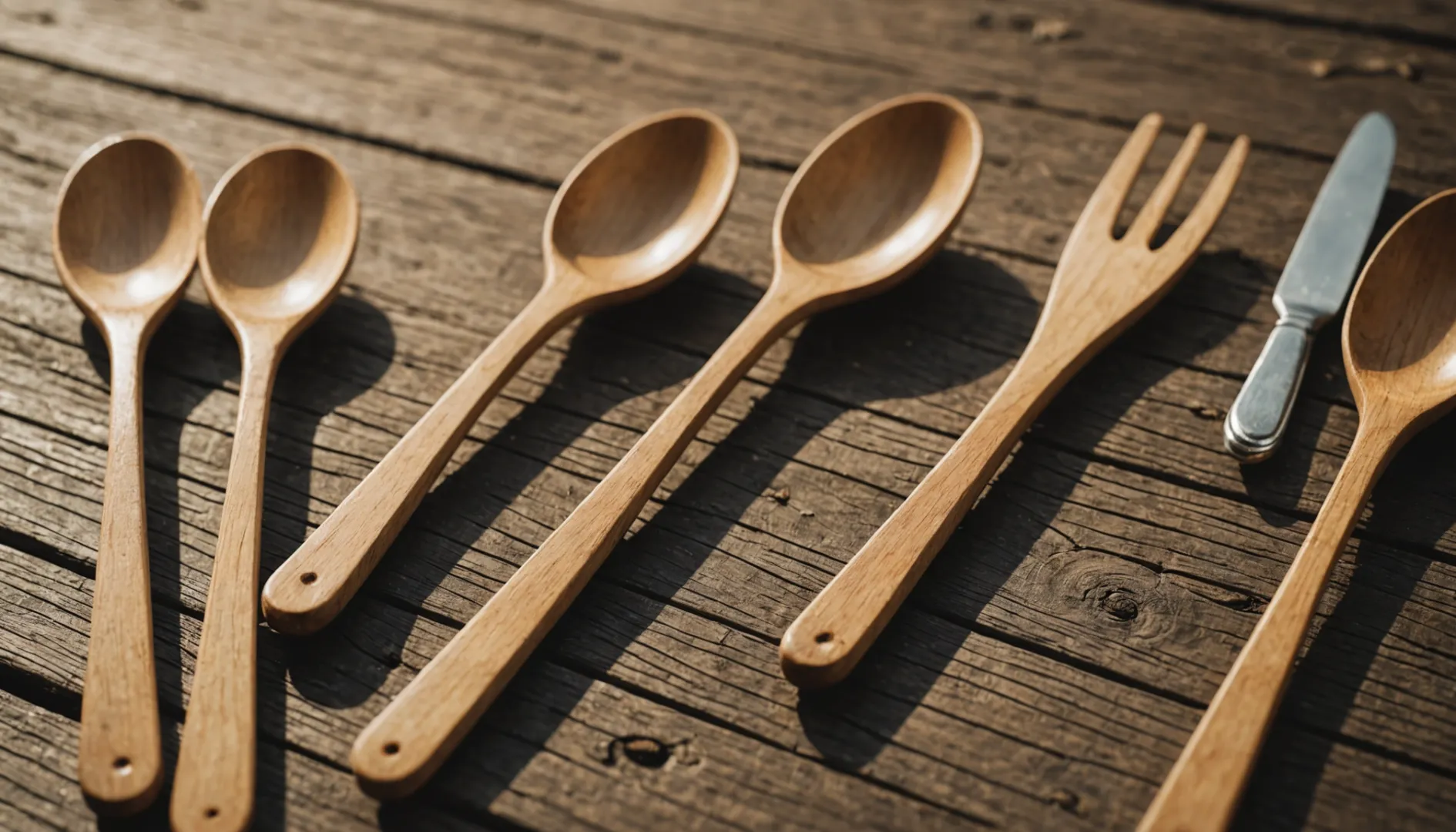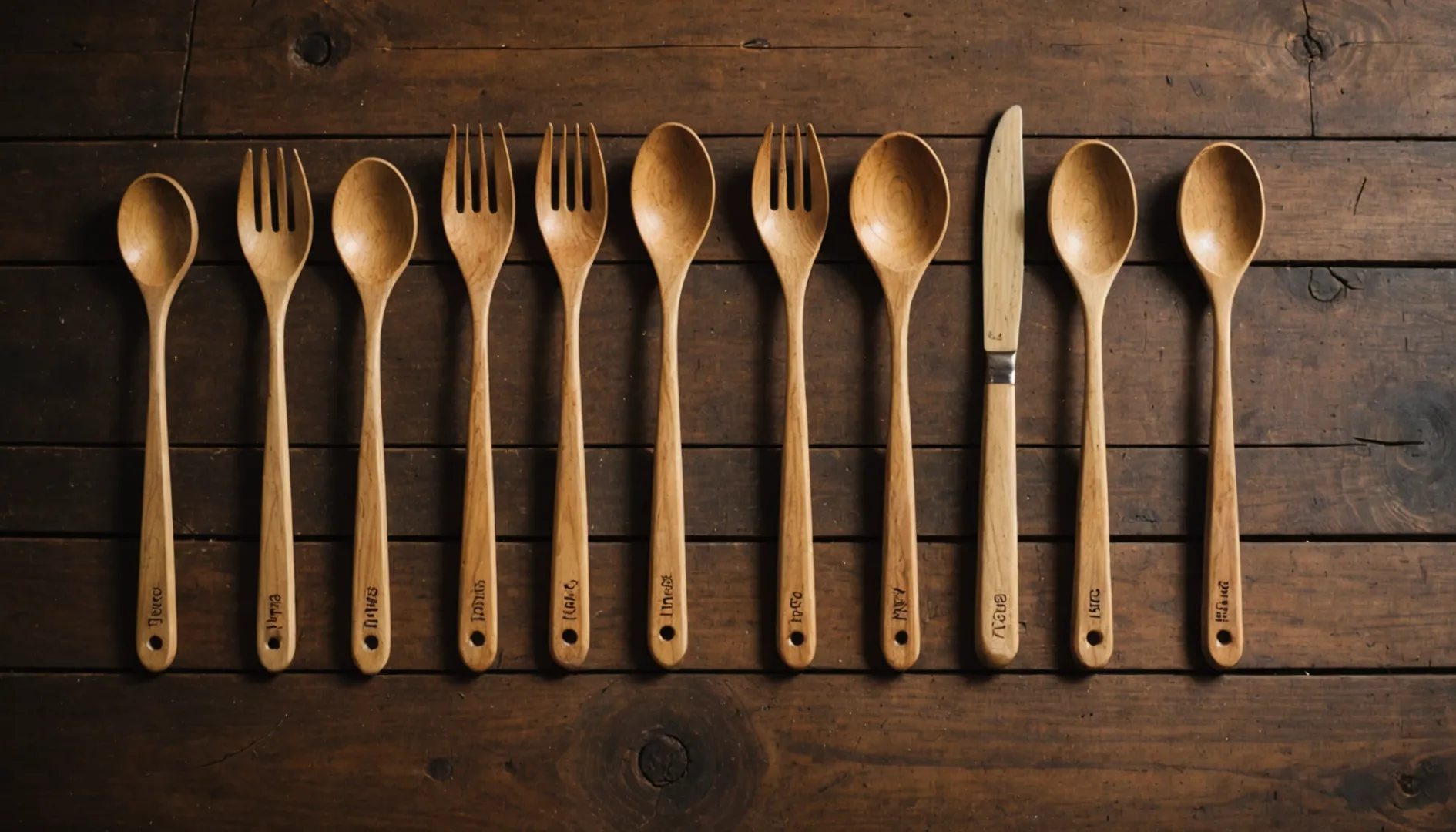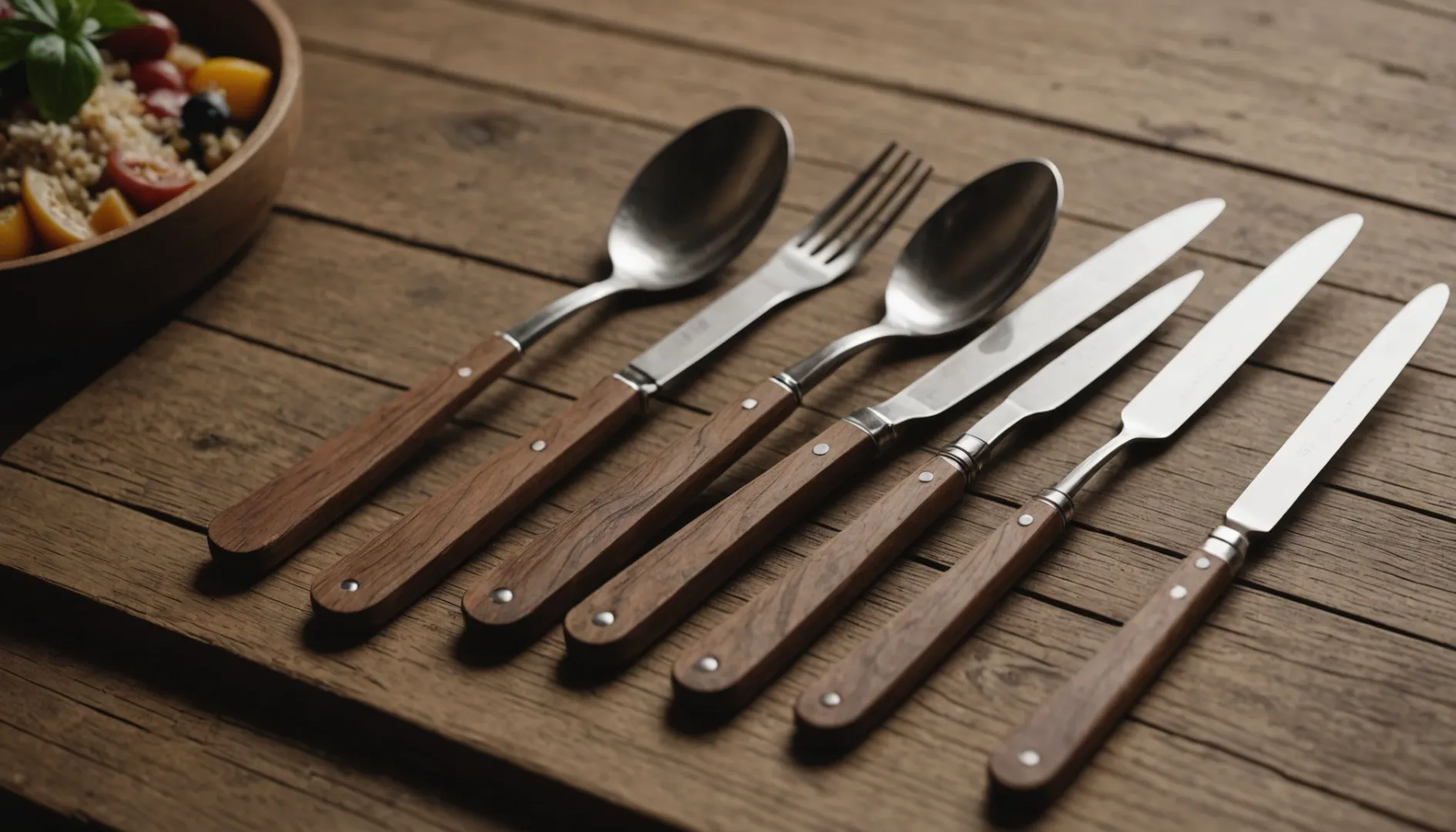
In a world increasingly focused on sustainability, choosing the right materials for your products is crucial.
Disposable wooden cutlery is a sustainable alternative to plastic, offering benefits like biodegradability, aesthetic appeal, and eco-certification. It’s ideal for ODM bulk orders due to its environmental advantages and market appeal.
While the initial benefits of wooden cutlery are clear, understanding its full potential requires a deeper dive into aspects like material sourcing, durability, and consumer preferences. Read on to discover why wooden utensils are becoming the preferred choice in today's market.
Wooden cutlery decomposes faster than plastic.True
Wooden cutlery is biodegradable and can decompose within months, unlike plastic.
How Does Wooden Cutlery Compare to Plastic in Terms of Sustainability?
In the quest for greener alternatives, how does wooden cutlery fare against its plastic counterpart?
Wooden cutlery stands out as more sustainable than plastic due to its biodegradability, lower environmental impact, and renewability. Unlike plastic, which lingers in landfills for centuries, wooden utensils decompose naturally and are often sourced from responsibly managed forests. This makes them a preferred choice for environmentally conscious consumers.

Environmental Impact of Wooden vs. Plastic Cutlery
When evaluating wooden cutlery1 against plastic options, the environmental implications are a major consideration. Plastic utensils contribute significantly to global pollution, taking hundreds of years to degrade. In contrast, wooden cutlery is biodegradable and can break down within months under composting conditions. Moreover, the production of plastic cutlery involves fossil fuels and emits substantial CO2, whereas wooden utensils generally have a lower carbon footprint.
Sourcing and Manufacturing Processes
The sustainability of wooden cutlery starts with responsible sourcing. Wood for these utensils often comes from sustainably managed forests, ensuring a continuous cycle of growth and harvest. Certifications like FSC (Forest Stewardship Council) ensure that the wood used is harvested legally and sustainably.
On the other hand, plastic cutlery is typically made from petroleum-based materials, which are non-renewable. This not only depletes natural resources but also contributes to habitat destruction and pollution during extraction and processing.
Decomposition and Disposal
A key advantage of wooden cutlery is its ability to decompose naturally. Post-use, these utensils can be composted, reducing landfill waste. This aligns with the growing trend towards zero-waste living.
Plastic cutlery poses disposal challenges as it is not biodegradable and recycling options are limited. Most plastics end up in landfills or oceans, causing long-term environmental damage.
Consumer Preferences and Market Trends
The shift towards sustainable living has heightened consumer interest in eco-friendly products. Wooden cutlery appeals not only for its environmental benefits but also for its aesthetic appeal and natural feel. Marketing strategies emphasizing these attributes resonate well with consumers seeking green alternatives.
In contrast, while plastic cutlery is often cheaper and more convenient, its environmental impact is prompting regulatory actions worldwide. Many regions are implementing bans on single-use plastics, further boosting the market for sustainable options like wooden cutlery.
Comparative Table: Wooden vs. Plastic Cutlery
| Aspect | Wooden Cutlery | Plastic Cutlery |
|---|---|---|
| Biodegradability | Biodegradable, compostable | Non-biodegradable, persists in environment |
| Resource Sourcing | Renewable sources (e.g., FSC-certified) | Non-renewable (petroleum-based) |
| Carbon Footprint | Lower CO2 emissions during production | Higher CO2 emissions during production |
| Disposal Impact | Minimal (compostable) | Significant (landfills/ocean pollution) |
| Consumer Appeal | High (aesthetic, eco-friendly image) | Low (growing negative perception) |
Exploring further into sustainable alternatives2, it becomes clear why wooden cutlery is gaining popularity in markets striving for environmental responsibility.
Wooden cutlery is biodegradable and compostable.True
Wooden cutlery decomposes naturally, reducing landfill waste.
Plastic cutlery has a lower carbon footprint than wooden.False
Plastic production emits more CO2 due to fossil fuel use.
What Are the Key Factors in Maintaining Wooden Cutlery's Longevity?
Wooden cutlery is an eco-friendly choice, but its lifespan hinges on proper care and maintenance.
To maintain wooden cutlery's longevity, regularly apply natural oils, hand wash with mild soap, and avoid prolonged moisture exposure. Proper drying and storage can prevent warping and bacterial growth, ensuring durability.

Understanding the Nature of Wood
Wood, being a natural material, requires special attention compared to synthetic options like plastic. Its porous nature makes it susceptible to moisture absorption, which can lead to swelling, cracking, or bacterial growth if not managed correctly. Regular maintenance with natural oils3 helps maintain its integrity and appeal.
Cleaning and Drying Practices
Proper cleaning is crucial. Always wash wooden cutlery by hand using mild soap and warm water. Avoid soaking them to prevent swelling or cracking. After washing, dry them immediately with a towel rather than air-drying, which can lead to moisture retention.
| Cleaning Method | Effectiveness | Risk of Damage |
|---|---|---|
| Hand Wash | High | Low |
| Dishwasher | Low | High |
Regular Conditioning
Over time, the natural finish on wooden utensils may wear off. Reapplying food-safe oils like mineral oil or beeswax can restore their sheen and protect against moisture and bacteria. This step is vital for extending the lifespan of your wooden cutlery.
Storage Considerations
Store wooden cutlery in a dry place away from direct sunlight or heat sources. This prevents the wood from drying out or becoming brittle. Using utensil holders that allow air circulation can also help maintain their condition.
Importance of Material Quality
The type of wood used significantly impacts durability. Hardwoods like maple or oak provide better resistance to wear and moisture than softer woods. Choosing high-quality materials can reduce the need for frequent maintenance.
Eco-Friendly Choices and Certifications
When selecting wooden cutlery, consider products with eco-certifications such as FSC (Forest Stewardship Council). These certifications ensure the wood is sourced sustainably, aligning with environmental values while guaranteeing product quality.
Maintaining wooden cutlery not only extends its functional life but also enhances its eco-friendly benefits. With proper care, these utensils can remain a sustainable choice in both household and commercial settings.
Wooden cutlery should be washed in a dishwasher.False
Dishwashers can damage wooden cutlery due to high heat and moisture.
Applying natural oils extends wooden cutlery's lifespan.True
Natural oils protect wood from moisture and bacterial growth, enhancing durability.
How Do Certifications Impact the Credibility of Wooden Utensils?
Certifications play a crucial role in enhancing the credibility of wooden utensils, ensuring they meet safety and sustainability standards.
Certifications such as FDA and FSC ensure that wooden utensils are safe for food contact and sourced sustainably. These certifications enhance the credibility and market appeal of wooden cutlery by validating their eco-friendly and health-conscious qualities.

Importance of Food Safety Certifications
Certifications like the FDA (Food and Drug Administration) and LFGB (Lebensmittel- und Futtermittelgesetzbuch) are essential for verifying that wooden utensils are safe for food contact. These certifications confirm that no harmful chemicals have been used in the production process, which is vital for consumer trust. The absence of toxins in certified wooden utensils also means they are safer alternatives to plastic, especially under high temperatures.
Role of Sustainability Certifications
Sustainability certifications such as the FSC (Forest Stewardship Council) assure consumers that the wood used in utensils is sourced from responsibly managed forests. This is particularly appealing in markets where environmental consciousness is a significant purchasing factor. Sustainably sourced materials4 not only help in preserving ecosystems but also promote ethical harvesting practices.
Enhancing Market Credibility
Certifications increase a product's credibility by providing measurable assurances about quality and sustainability. Life Cycle Analysis (LCA) is another tool companies use to demonstrate environmental impact, offering data on energy use, carbon footprint, and resource efficiency. Understanding LCA5 can provide insights into how wooden utensils stack up against competitors, particularly in regions with stringent environmental regulations.
Transparency and Traceability
Blockchain technology is emerging as a tool for verifying the traceability of wooden utensils from forest to table. This technology allows manufacturers to document each step in the supply chain, ensuring transparency and fostering consumer trust. Blockchain applications in supply chain6 can significantly enhance a brand's reputation by aligning with consumer demands for ethical sourcing.
Consumer Perceptions
Eco-certifications not only affect how products are perceived in terms of safety and sustainability but also influence purchasing decisions. Consumers are increasingly prioritizing products that carry credible certifications, associating them with higher quality and ethical standards. In fact, brands that leverage their certifications effectively often see increased demand and can even command higher price points in the market.
FSC certification ensures sustainable wood sourcing.True
FSC certifies that wood is sourced from responsibly managed forests.
FDA certification is irrelevant for wooden utensils.False
FDA certification verifies that wooden utensils are safe for food contact.
What Role Does Innovation Play in the Evolution of Wooden Cutlery?
Innovation is transforming wooden cutlery from simple tools to eco-friendly, efficient utensils.
Innovation in wooden cutlery focuses on resource efficiency, sustainable materials, and improved functionality, making it a compelling alternative to plastic utensils. This evolution addresses environmental concerns while enhancing usability and longevity.

The Drive for Resource Efficiency
One significant area of innovation in wooden cutlery is the focus on resource efficiency. Manufacturers are adopting minimalist designs that use less wood without compromising strength and durability. This approach not only reduces material costs but also minimizes environmental impact. Additionally, some companies are experimenting with combining materials like bamboo fiber with wood, which increases strength while keeping the utensils lightweight.
Enhancing Biodegradability
Another innovation is in biodegradable coatings that aim to make wooden cutlery break down faster after disposal. These coatings often come from compostable materials that enhance the overall biodegradability of the utensils. Some innovative products are designed to decompose within months, providing an eco-friendly solution compared to traditional plastics.
Improving Hygiene and Usability
The porous nature of wood can make it susceptible to bacterial growth, a challenge that innovation has addressed through natural coatings or oil treatments. These treatments create a smoother surface, resisting water and bacteria, and are safe for food contact. Such enhancements not only improve hygiene but also extend the usability of wooden cutlery, making it a viable choice for both disposable and reusable options.
Integrating Technology and Design
Innovation isn’t just about materials; it also involves integrating technology for enhanced traceability and sustainability assurance. Technologies like blockchain are used to track the wood from forest to factory, ensuring sustainable sourcing and legal compliance. Such transparency builds trust with eco-conscious consumers who demand proof of environmental responsibility.
Meeting Market Demands
The global demand for eco-friendly products has pushed the evolution of wooden cutlery, especially in regions like Europe and North America where environmental regulations are stringent. Innovations in design and material sourcing ensure that wooden cutlery not only meets these standards but also appeals to consumers' aesthetic preferences. The result is a product that’s both practical and aligned with market trends.
With these innovations, wooden cutlery emerges7 as a sustainable, practical alternative to plastic utensils, meeting the needs of environmentally conscious consumers and businesses alike.
Wooden cutlery is more eco-friendly than plastic.True
Wooden cutlery uses sustainable materials and biodegradable coatings, reducing environmental impact.
Bamboo fiber weakens wooden cutlery.False
Bamboo fiber strengthens wooden cutlery while keeping it lightweight.
Conclusion
Choosing wooden cutlery aligns with sustainability goals and market trends. With proper care and sourcing, these utensils offer both ecological and aesthetic benefits.
-
Learn about the ecological benefits of choosing wooden over plastic utensils.: The biggest upside of using wood to replace plastic cutlery is that it's a natural, renewable material. This means no fossil-based ingredients are needed to ... ↩
-
Discover more eco-friendly options beyond wooden utensils.: 1. Compostable Cutlery. One popular alternative to plastic cutlery is compostable cutlery. This type of cutlery is made from natural materials ... ↩
-
Learn how natural oils can preserve and protect wooden utensils.: Apply the oil: Using a clean, soft cloth or paper towel, apply the oil in an even layer over the wood. Let it soak in: Leave the oil to soak in, overnight ... ↩
-
Learn how FSC certification ensures sustainable wood sourcing.: FSC has earned a reputation as the most rigorous, credible forest certification system. As a result, there are significant advantages to choosing FSC-certified ... ↩
-
Discover how LCA enhances environmental credibility.: Discover the sustainability of wooden cutlery through a detailed life cycle analysis, comparing its eco-impact to plastic alternatives. ↩
-
Explore blockchain's role in ensuring ethical sourcing.: Blockchain can greatly improve supply chains by enabling faster and more cost-efficient delivery of products, enhancing products' traceability, improving ... ↩
-
Explore how modern innovations improve wooden cutlery's sustainability and usability.: Celebration Packaging has developed a zero-touch dispenser for disposable wooden cutlery, striving for a hygienic, convenient, and sustainable solution for ... ↩

